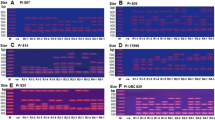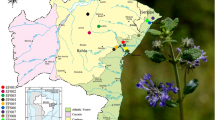Abstract
Salvia desoleana Atzei et Picci is a herbaceous perennial plant endemic to Sardinia, Italy. Its leaves are a source of essential oil, used in the pharmaceutical and cosmetic industries. Due to the increasing interest in the essential oils production, cultivated accessions have supplanted many wild populations which had become small, fragmented and isolated with a serious risk of genetic erosion. With the aim of preserving the local genetic diversity, AFLP fingerprinting has been used to facilitate the comprehensive evaluation of both cultivated and wild S. desoleana populations. A set of 165 polymorphic AFLP fragments was generated, revealing a genetic diversity (He) ranging from 0.11 to 0.22 in wild and cultivated populations respectively. Two major clusters were revealed by STRUCTURE analysis, one including wild and the other capturing the cultivated accessions. The divergence between the cultivated and wild materials was also confirmed by the analysis of molecular variance (FST = 0.52). GC/MS analysis performed on the essential oil extracts identified 37 compounds, eight of which (1,8 cineole, terpinolene, α and β thujone, camphor, terpinyl acetate, germacrene D and linalyl acetate) were strongly represented. Three main fractions were identified in the essential oils: monoterpenes, sesquiterpenes and diterpenes. All terpenes levels were significantly correlated with the AFLP genetic clusters (P < 0.0001), suggesting close correspondence between genetic groups and chemical profiles. This work aims to describe the integrated investigation of genetic and chemical diversity of S. desolena germoplasm, in order to improve the species yield and to plan a future conservation strategy.



Similar content being viewed by others
References
Adams RP, Identification of essential oil components by gas chromatography/mass spectroscopy (2001) Fourth ed. Carol Stream, Illinois, Allured Publishing Corporation
Atzei AD, Picci V (1982) “Salvia desoleana” Atzei et Picci, specie nuova dell’isola di Sardegna. Webbia 36(1):71–78
Baricevic D, Sosa S, Della Loggia R, Tubaro A, Simonovska B, Krasna A, Zupancic A (2001) Topical anti-inflammatory activity of Salvia officinalis L. leaves: the relevance of ursolic acid. J Ethnopharmacol 75:125–132
Bassam BJ, Caetano-Anolles G, Gresshoff PM (1991) Fast and sensitive silver staining of DNA in polyacrylamide gels. Anal Biochem 196:80–83
Boszormenyi A, Hethelyi E, Farkas A, Horvath G, Papp N, Lemberkovics E, Szoke E (2009) Chemical and genetic relationships among sage (Salvia officinalis L.) cultivars and Judean sage (Salvia judaica Boiss.). J Agric Food Chem 11:4663–4667
Braglia L, Casabianca V, De Benedetti L, Pecchioni N, Mercuri A, Cervelli C, Ruffoni B (2011) Amplified fragment length polymorphism markers for DNA fingerprinting in the genus Salvia. Plant Biosyst 145(2):274–277
Camarda I (1984) Le Piante endemiche della Sardegna:148. Bollettino della Società sarda di scienze naturali 23: pp 261–265. ISSN 0392-6710
Ceschel GC, Maffei P, Moretti MD, Demontis S, Peana AT (2000) In vitro permeation through porcine buccal mucosa of Salvia desoleana Atzei & Picci essential oil from topical formulations. Int J Pharm 195:171–177
Claßen-Bockhoff R, Wester P, Tweraser E (2003) The stamina lever mechanism in Salvia L. (Lamiaceae)—a review. Plant Biol 5:33–41
Clebsch B (2003) The new book of Salvias: sages for every garden. Timber Press, Portland
Diana-Corrias S (1983) Numeri cromosomici per la Flora Italiana: 948–955. Informatore Botanico Italiano 15(I): 44–48
Dosset M, Bassil NV, Finn CE (2010) Transferability of Rubus microsatellite markers to black raspberry. Acta Hortic 859:103–106
El–Kassaby YA, Ritland K (1996) Impact of selection and breeding on the genetic diversity in Douglas-fir. Biodivers Conserv 5(6):795–813
Evanno G, Regnaut S, Goudet J (2005) How to use the software structure: a simulation study. Mol Ecol 14:2611–2620
Excoffier L, Heckel G (2006) Computer programs for population genetics data analysis: a survival guide. Nat Rev Genet 7:745–758
Faegri K, Van der Piji L (1979) The principles of pollination ecology. Pergamon Press, Oxford
Farag RS, Salem H, Badei AZMA, Hassanein DE (1986) Biochemical studies on the essential oil of some medicinal plants. Fett Seifen Anstr 88:69–72
Farmacopea Ufficiale Italiana (2008) XII edizione
Ferriol M, Picò B, Nuez F (2003) Genetic diversity of a germplasm collection of Cucurbita pepo using SRAP and AFLP markers. Theor Appl Genet 107:271–282
Figueiredo AC, Barroso JG, Pedro LG, Scheffer JJC (2008) Factors affecting secondary metabolite production in plants: volatile components and essential oils. Flavor Fragr J 23(4):213–226
Guo BL, Feng YX, Zhao YJ (2002) Review of germplasm resources studies on Salvia miltiorrhiza. China J Chin Mater Med 27:492–495
Huff DR (1997) RAPD Characterization of heterogeneous perennial ryegrass cultivars. Crop Sci 37(2):557–564
Jennings W, Shibamoto T (1980) Qualitative analysis of flavour and fragrance volatiles by glass capillary gas chromatography. Academic Press, New York
JMP ver. 7. Copyright © (2007) by SAS Institute Inc. Cary, NC
Joulain D, König WA (1998) The atlas of spectral data of sesquiterpenes hydrocarbons. E.B.-Verlag Hamburg, Germany
Karaca M, Ince AG, Ay ST, Turgut K, Onus AN (2008) PCR-RFLP and DAMD-PCR genotyping for Salvia species. J Sci Food Agric 88:2508–2516
Kennedy BS, Nielsen MT, Severson RF, Sisson VA, Stephenson MK, Jackson DM (1992) Leaf surface chemicals from Nicotiana affecting germination of Peronospora tabacina (Adam) sporangia. J Chem Ecol 18:1467–1479
Linstrom PJ, Mallard WG (eds) (2005) NIST Chemistry WebBook, NIST Standard Reference Data-base Number 69. National Institute of Standards and Technology, Gaithersburg, 20899. http://webbook.nist.gov2005
Marchioni AH, Di Stefano FC (1980) Le piante medicinali della Sardegna, guida pratica per il riconoscimento di 102 specie. Edizioni La Torre, Cagliari p 236
Marongiu B, Porcedda S, Della Porta G, Reverchon E (2001) Extraction and isolation of Salvia desoleana and Mentha spicata subsp. insularis essential oils by supercritical CO2. Flavor Fragr J 16:384–388
McLafferty FW, Stauffer DB (1988) The Wiley NBS registry of mass spectral data, 4th edn. New York, Wiley-Interscience
McLafferty FW, Stauffer DB (1994) The Wiley NBS registry of mass spectral data, 6th edn. New York, Wiley-Interscience
Médail F, Quezel P (1999) Biodiversity hot-spots in the Mediterranean Basin: setting global 25 conservation priorities. Conserv Biol 13:1510–1513
Melito S, Chessa I, Erre P, Podani J, Mulas M (2013a) The genetic diversity of Sardinian myrtle (Myrtus communis L.) populations. Electron J Biotech 16(6): Issue of November 15
Melito S, Sias A, Petretto GL, Chessa M, Pintore G, Porceddu A (2013b) Genetic and metabolite diversity of Sardinian populations of Helichrysum italicum. PLoS One 8(11):e79043. doi:10.1371/journal.pone.0079043
Nei M, Li WH (1979) Mathematical model for studying genetic variation in terms of restriction endonuclease. Proc Natl Acad Sci USA 76:5269–5273
Peana A, Moretti MD, Juliano C (1999) Chemical composition and antimicrobial action of the essential oils of Salvia desoleana and S. sclarea. Planta Med 65:752–754
Peana A, Satta M, Moretti MDL, Orecchioni M (1994) A study on choleretic activity of Salvia desoleana essential oil. Planta Med 60(7):478–479
Peana AT, Moretti MDL (2002) Pharmacological activities and applications of Salvia sclarea and Salvia desoleana essential oils. A Ur-Rahman (ed.) Studies in natural product chemistry, vol 26, part G. Elsevier, UK, pp. 391–425
Pitarokili D, Couladis M, Petsikos-Panayotarou N, Tzacou O (2002) Composition and antifungal activity on soil-borne pathogens of the essential oil of Salvia sclarea from Greece. J Agric Food Chem 50:6688–6691
Pritchard JK, Wen X, Falush D (2007) Documentation for structure software, version 2.2. http://pritch.bsd.uchicago.edu/software
Radosavljević I, Satovic Z, Jakse J, Javornik B, Greguraš D, Jug-Dujaković M, Liber Z (2012) Development of new microsatellite markers for Salvia officinalis L. and its potential use in conservation-genetic studies of narrow endemic Salvia brachyodon vandas. Int J Mol Sci 13:12082–12093
Sazima I, Buzato S, Sazima M (1995) An assemblage of hummingbird-pollinated flowers in a montane forest in Southeastern Brazil. Bot Acta 109:149–160
Skoula M, El Halali E, Markis AM (1999) Evaluation of the genetic diversity of Salvia fruticosa Mill. Clones using RAPD markers and comparison with the essential oil profiles. Biochem Syst Ecol 27:559–568
Sokovic MD, Brkic DB, Dzamic AM, Ristic MS, Marin PD (2009) Chemical composition and antifungal activity of Salvia desoleana Atzei & Picci essential oil and its major components. Flavor Fragr J 24:83–87
Song Z, Li X, Wang H, Wang J (2010) Genetic diversity and population structure of Salvia miltiorrhiza Bge in China revealed by ISSR and SRAP. Genetica 138(2):241–249
Thompson JD (2005) Plant evolution in the mediterranean. Oxford University Press, Oxford
Tosun A, Khan S, Kim YS, Calín-Sánchez Á, Hysenaj X, Carbonell-Barrachina ÁA (2014) Essential oil composition and anti-inflammatory activity of Salvia officinalis L. (Lamiaceae) in murin macrophages. Trop J Pharm Res 13(6):937–942
Ulubelen A, Topcu G, Eris C, Sonmez U, Kartal M, Kurucu S, Bozok-Johansson C (1994) Terpenoids from Salvia sclarea. Phytochemistry 36(4):971–974
Walker JB, Sytsma KJ, Treutlein J, Wink M (2004) Salvia (Lamiaceae) is not monophyletic: implications for the systematics, radiation, and ecological specializations of Salvia and tribe Mentheae. Am J Bot 91(7):1115–1125
Van de Peer Y, De Wachter R (1994) TREECON for Windows: a software package for the construction and drawing of evolutionary trees for the Microsoft Windows environment. Comput Appl Biosci 10:569–570
Vos P, Hogers R, Bleeker M, Reijans M, Van De Lee T, Hornes M, Frijters A, Pot J, Peleman J, Kuiper M, Zabeau M (1995) AFLP: a new technique for DNA fingerprinting. Nucleic Acids Res 23:4407–4417
Yeh FC, Boyle TJB (1997) Population genetic analysis of co-dominant and dominant markers and quantitative traits. Belg J Bot 129:157
Zhang Y, Xing L, Zhezhi W (2013) Diversity evaluation of Salvia milthiorrhiza using ISSR markers. Biochem Genet 51:707–721
Acknowledgments
The research was supported by Fondazione Banco di Sardegna (Sassari): “In vitro production of secondary metabolite from medicinal plants” project (Principal Investigator: Grazia Maria Scarpa); RAS—Regione Autonoma della Sardegna “Master and Back” program 2011 (Postdoctoral fellowship “Back”).
Author information
Authors and Affiliations
Corresponding author
Electronic supplementary material
Below is the link to the electronic supplementary material.
Figure S1
Analysis of population genetic structure performed on Cluster A (CA) and Cluster B (CB). CA harbored two sub-groups CAI and CAII; while no further subgroups were discriminated in CB. (TIFF 257 kb)
Table S1
Adapter and primer sequences used for AFLP fingerprinting. (DOC 32 kb)
Table S2
FST Probability value matrix among the Salvia spp populations based on 10,000 permutations. (DOC 36 kb)
Rights and permissions
About this article
Cite this article
Rapposelli, E., Melito, S., Barmina, G.G. et al. AFLP fingerprinting and essential oil profiling of cultivated and wild populations of Sardinian Salvia desoleana . Genet Resour Crop Evol 62, 959–970 (2015). https://doi.org/10.1007/s10722-015-0263-1
Received:
Accepted:
Published:
Issue Date:
DOI: https://doi.org/10.1007/s10722-015-0263-1




